Drawing lessons or how the movie "Freefall Second" was shot
The phrase is very popular at filming: “Ah, figs with him, we’ll finish the post-sales!” Such a wonderful thing, as finalization on the post-production of the filming "FIG with him," and this article is devoted. Here I will talk about personal experiences and the benefits of using this spell while working on the short film “Free Fall Seconds,” of which I am the director.

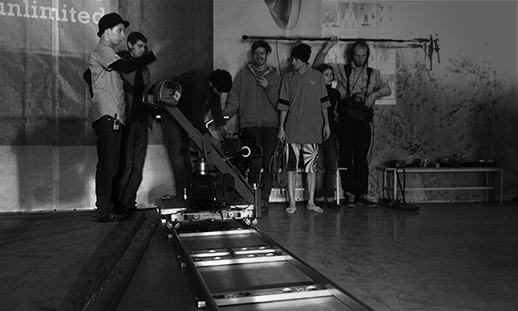
Before filming, I did not plan to use digital processing at all (with the exception of color grading), wanting to achieve the most realistic image. Well, well! .. The magic "figs with him" has incredible power, all sorcerers know this!
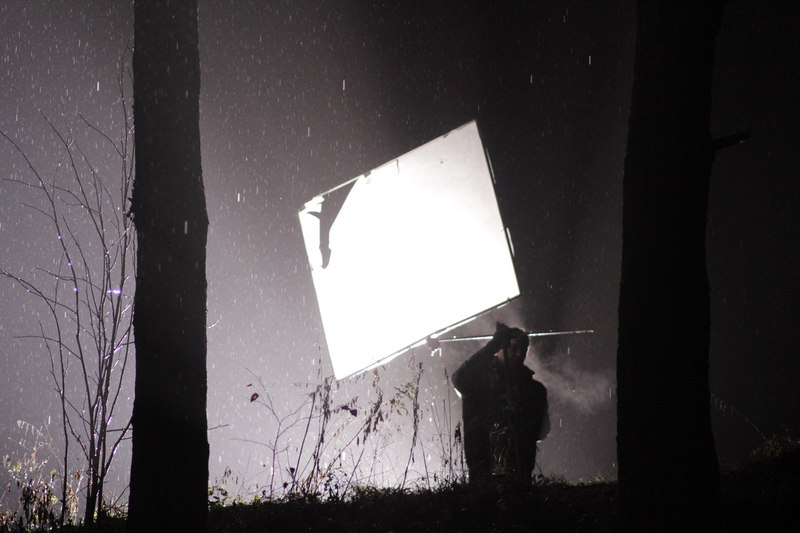
I'll start by filming in the forest. If everything is simple and clear with daytime shots, I had to spend on night shots. A van with a generator, a bunch of lighting fixtures illuminating the radiance of camera work night, then color correction in the hope of achieving the desired shade ... Everything went almost according to plan. At least postproduction didn't have to be postponed. Almost ... In the clutter of filming, picking up details of the night without actors, however, was not fate. And the details are needed. But the daily parts of the forest - at least sell at the Air Force! The solution turned out to be logical: we take daytime shots and ... we make night shots from them. Brilliant, isn't it? The main thing is aggressive color correction. And the more aggressive the better!
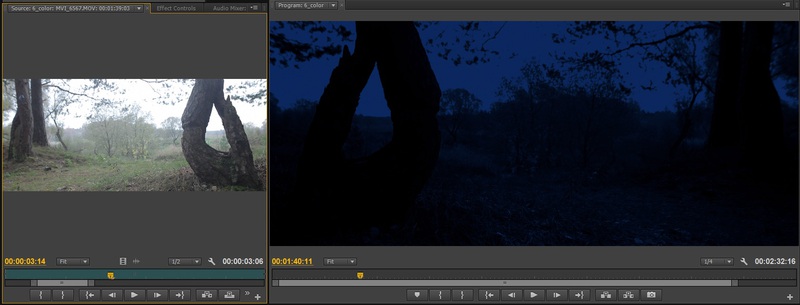
But in the episode with the rain, the fun itself began. In the story, the actors get wet in the rain and ... um, kiss. The initial shooting plan was as follows: to sit near the river, throw the end of the hose with the pump into the water, and hand the other end to the assistant director, and exclaim: “Oh, God of Rain, give us moisture!”, Enjoy the view of the weeping actors, while hiding himself under the umbrella. But if everything was so, this article would not have appeared, do you understand? .. The Rain God in the person of a younger person, of course, gave us moisture and the actors - as they should be - got wet. Only the God of Rain - just the God of Rain, and not the God of Gravity - and the droplets flew somehow crookedly, then fell on the actors, then flew the devil knows where. And we, having conferred, decided: "Ah, figs with him, at the post-sales we draw!"
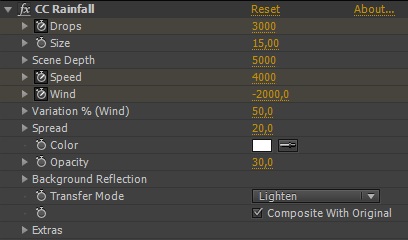
As you can see, the settings are animated - this allowed us to change the direction of the wind, the strength and depth of the rain inside each frame, which adds realism.
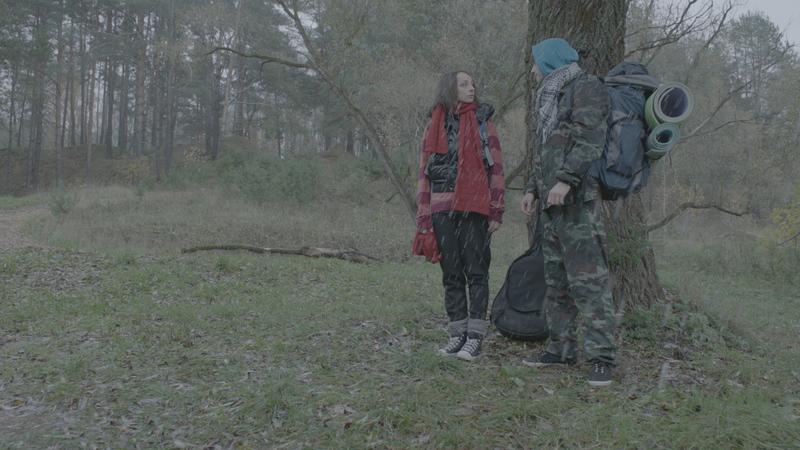

But according to the plan, we still had to shoot rapid shots. Quote from the director's script: "Rain drops slowly flowing down Katya’s face." I wrote, it seems, not bad, but how to implement the composition of an inflamed brain - you will break your head ... The shooting was conducted on Arri Alexa, the maximum frequency of which is 60 fps. We did not have enough money on Red Epic, and 60 fps is not able to give a proper deceleration. Well hello Twixtor! The film has a lot of slow motion - and all of them were presented to us by our favorite Twixtor plugin. There is a special operation with the twixstor, the quality of the slowdown strongly depends on the quality of the footage: clarity is important, the absence of blurry “intermediate” phases of movement, the absence of camera jerks, the monotony of the background, the maximum contrast of the background and the slowed-down object — what am I crucified if you know the word tweakstore, all this is already known!falling actor stuntman from the roof, the rope unnaturally twitches. The reason for this is the blurry movement of the rope on the footage.
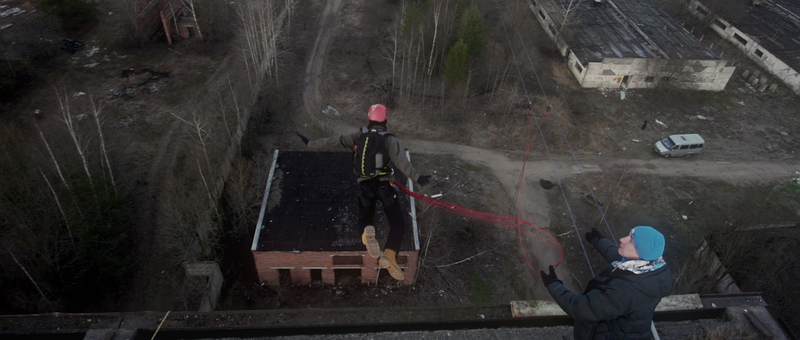
The “double” rope is clearly visible in the freeze frame.
But back to the forest rain. The God of Rain on our site, of course, was cool, but not so cool as to conjure falling drops meeeeeally. He is only the God of Rain, and not the God of Gravity. I had to draw in after. This is the standard CC Mr. effect. Mercury, which gives a sensation of moisture adhering to the lens (and if you add a burgundy shade, it also drains blood on the screen), but when you dig deeper into the settings no worse than your nose, you get the illusion of slowly falling drops outside the lens border.

On each frame with drops, three to five layers are created with this effect. The Radius and Producer settings on each layer are different - this allows you to create the illusion of the depth of the frame without working in 3D space.
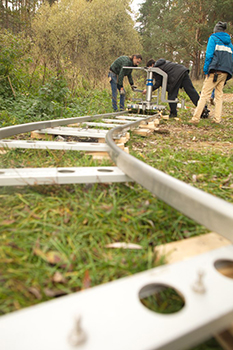
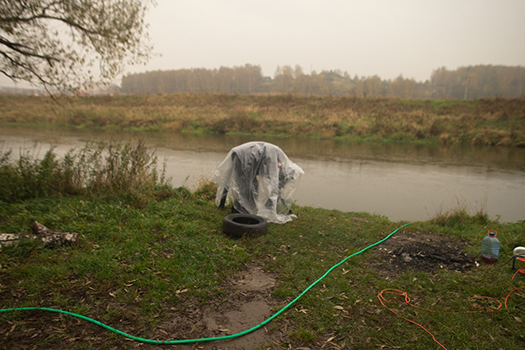
Having shot the general plans with the rain and having driven the operator to the dolly, it is time for large and medium plans. Suddenly, the battery was near the camera. The God of Electricity would have saved us here, but, alas, he wasn’t on the site - a mechanic with a spare battery was stuck in an “unforeseen” Moscow traffic jam at that time. The film crew eventually waited for him, but the sun did not wait for him. They decided to finish the rain later. When this “later” came, the temperature on the street dropped to zero degrees and I, when I thought about the movie rain,somehow became uncomfortable for the actorsI didn’t want to stand under an umbrella in such a cold. And close-ups were finished in the pavilion. The Rain God this time was with a watering can. Nearby stood a bucket of "reserve" water and one of the admins constantly updated this "reserve" water. Behind the weeping — as it should be — actors were a chromakey.

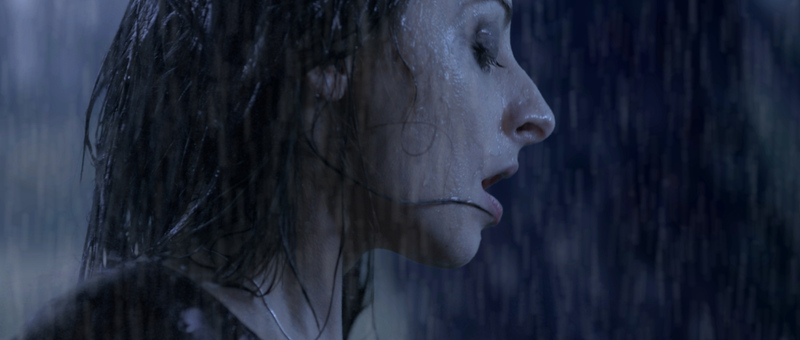
Now we will pass to the most juicy. “Free Fall Seconds” is a picture of the roopjumpers. And what's the point of watching a movie about extremals if the shooting was not extreme? No, the truth is like silicone boobs! There are many ways to raise a camera into the air without using computer graphics: a crane, ropes, quadrocopter, helicopter, etc. - but at least an orbiting satellite or kamikaze with a lens on its forehead! Each of these methods has its own nuances, image subtleties, geo-referencing, dependence on wind speed and direction, presence / absence of precipitation, there are specifics of camera movement such as smoothness, speed, elevation, etc.
During the pre-production, the idea was to pull the ropes tens of meters and send the operator to hang out at a height of 10-12 floors. But only one operator was available, which caused some complications ... A version of a camera rushing on cables was thought out, flying out over the edge of the crane roof and, as an option, an unnecessary crew member falling from thirty meters. But, thanks to the efforts of the executive producer, an optimal option was found that meets almost all requests for the necessary picture and fits into the budget without human casualties (which is probably important). Radio-controlled helicopter.
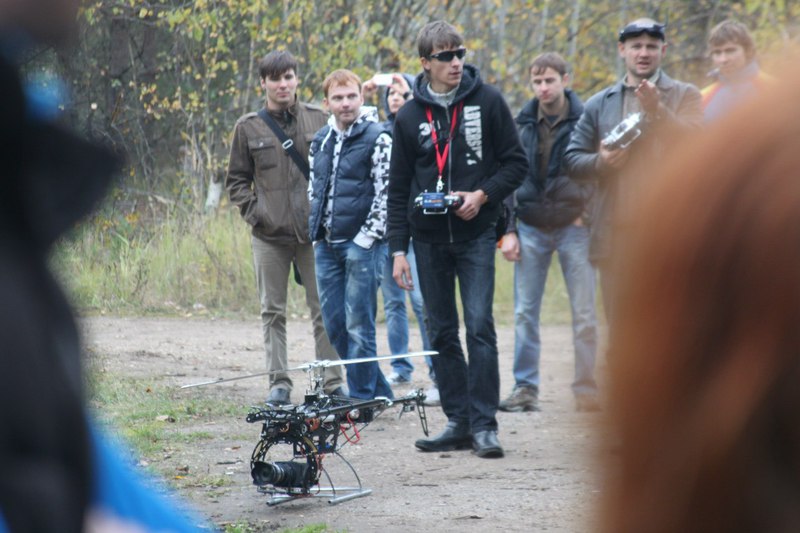
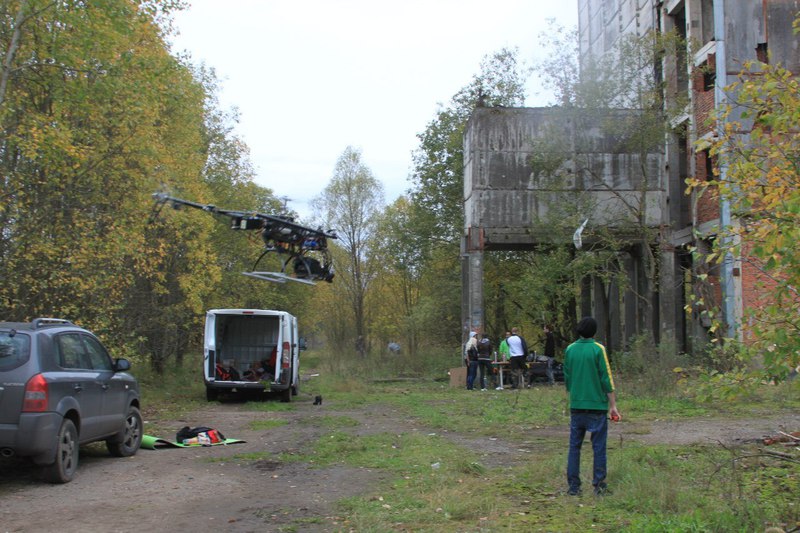
Let the word “radio-controlled” not bother you - this toy requires no less care than a transformer. It is controlled by two people: a pilot with a remote control and a cameraman with virtual glasses. The signal from virtual glasses is also duplicated on the director’s monitor. What is missing is perhaps the AI controlling this action from some Deus Ex. However, who knows .......... The duration of the flight in our case is 15 minutes, after which the helicopter must be put on a “refueling”. The load capacity is small, Arri Alexa will not be able to hang, so aerial photography was carried out on Sony FS. Cons of this technical unit: a huge dependence on weather conditions. One of the filming shifts was frustrated due to the sudden onset of rain (there wasn’t any Rain God with us that day, and the weather forecast in the fall for every day is typical and very promising: variable cloud cover), why a tenth of the budget of the film safely disappeared into a puddle. Due to air turbulence, our blade robot was not able to vertically climb 30 meters or more along the building, because there was a danger of collapse, but away from the building or diagonally towards the walls of the building - please. Need in five seconds? - easy! Neither the crane, nor (as far as I know) the quadrocopter is capable of this. A panoramic span of fifty or more meters - in general, beauty! But here the second significant minus immediately makes itself felt. Stabilization. There is always a small proportion of shaking in such shootings (didn’t forget about the “fig with him” spell?), But this is easily stabilized by tracking. Personally, I used the plug-in for After Effects - the easiest to learn Mercalli. Even home cockroaches are able to use it. Due to air turbulence, our blade robot was not able to vertically climb 30 meters or more along the building, because there was a danger of collapse, but away from the building or diagonally towards the walls of the building - please. Need in five seconds? - easy! Neither the crane, nor (as far as I know) the quadrocopter is capable of this. A panoramic span of fifty or more meters - in general, beauty! But here the second significant minus immediately makes itself felt. Stabilization. There is always a small proportion of shaking in such shootings (didn’t forget about the “fig with him” spell?), But this is easily stabilized by tracking. Personally, I used the plug-in for After Effects - the easiest to learn Mercalli. Even home cockroaches are able to use it. Due to air turbulence, our blade robot was not able to vertically climb 30 meters or more along the building, because there was a danger of collapse, but away from the building or diagonally towards the walls of the building - please. Need in five seconds? - easy! Neither the crane, nor (as far as I know) the quadrocopter is capable of this. A panoramic span of fifty or more meters - in general, beauty! But here the second significant minus immediately makes itself felt. Stabilization. There is always a small proportion of shaking in such shootings (didn’t forget about the “fig with him” spell?), But this is easily stabilized by tracking. Personally, I used the plug-in for After Effects - the easiest to learn Mercalli. Even home cockroaches are able to use it. for there was a danger of collapse, but at a distance from the building or diagonally towards the walls of the building - please. Need in five seconds? - easy! Neither the crane, nor (as far as I know) the quadrocopter is capable of this. A panoramic span of fifty or more meters - in general, beauty! But here the second significant minus immediately makes itself felt. Stabilization. There is always a small proportion of shaking in such shootings (didn’t forget about the “fig with him” spell?), But this is easily stabilized by tracking. Personally, I used the plug-in for After Effects - the easiest to learn Mercalli. Even home cockroaches are able to use it. for there was a danger of collapse, but at a distance from the building or diagonally towards the walls of the building - please. Need in five seconds? - easy! Neither the crane, nor (as far as I know) the quadrocopter is capable of this. A panoramic span of fifty or more meters - in general, beauty! But here the second significant minus immediately makes itself felt. Stabilization. There is always a small proportion of shaking in such shootings (didn’t forget about the “fig with him” spell?), But this is easily stabilized by tracking. Personally, I used the plug-in for After Effects - the easiest to learn Mercalli. Even home cockroaches are able to use it. A panoramic span of fifty or more meters - in general, beauty! But here the second significant minus immediately makes itself felt. Stabilization. There is always a small proportion of shaking in such shootings (didn’t forget about the “fig with him” spell?), But this is easily stabilized by tracking. Personally, I used the plug-in for After Effects - the easiest to learn Mercalli. Even home cockroaches are able to use it. A panoramic span of fifty or more meters - in general, beauty! But here the second significant minus immediately makes itself felt. Stabilization. There is always a small proportion of shaking in such shootings (didn’t forget about the “fig with him” spell?), But this is easily stabilized by tracking. Personally, I used the plug-in for After Effects - the easiest to learn Mercalli. Even home cockroaches are able to use it.

After tracking, a second difficulty arises. If you leave helicopter frames at real playback speed, then everything is OK: after digital stabilization, no one will notice the shaking that was once present. But I accelerated many frames ten times that way ... As a result, after tracking there were artifacts that I couldn’t get rid of - a promising distortion. I will explain briefly for those who are in the tank, and not in the helicopter: due to gusts of wind, the radio-controlled bird tilts in one direction or the other. If the playback speed is the same as during the shooting, then after tracking no one will pay attention to it. But it’s worth accelerating the reproduction, as the eye begins to notice that the camera is “swaying”. Just like at the exit of the bar. And the higher the playback speed, the more noticeable "staggering." Tracking stabilizes shaking
In the episode where the hero climbs over the railing and jumps from the railway bridge, the viewer might think that the actor really jumps from the 25 meter bridge. In general, I insisted on this, but for some reason the actor wanted to live. Therefore, I had to take up a simple cinematic technique. As is known to all owners of the brain, the railing at the bridges does not begin at the maximum height. So in our case - from the actor jumping from the bridge to the ground there were no more than two meters, and the angle was chosen so that the viewer did not see the ground. It remains only to put on the montage next to the frame with the feet of the hero on the edge of the abyss - and the illusion of height is provided.
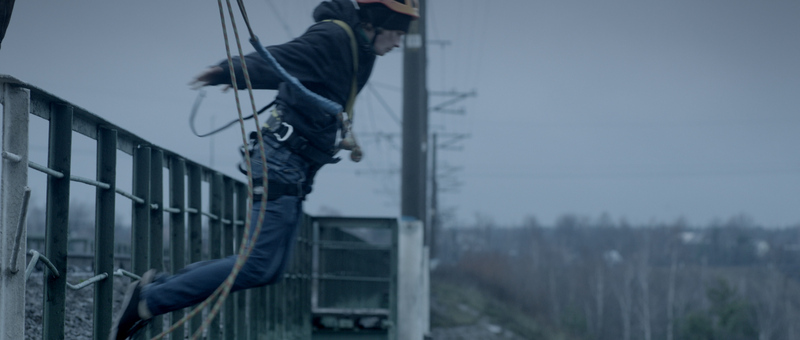
All interior shooting (not including a climbing wall) is a pavilion. They even rented a tent in the pavilion. When we see a city outside the window, in fact we see a green screen (I’m talking about a movie, not about your window). Of course, I was not averse to putting a hologram, but someone whispered in my ear that this was a little expensive. Frames with a night view were shot separately on a time-lapse recorder with a shooting frequency of one frame in five seconds. That is why in the film the lights outside the window blink pleasantly.
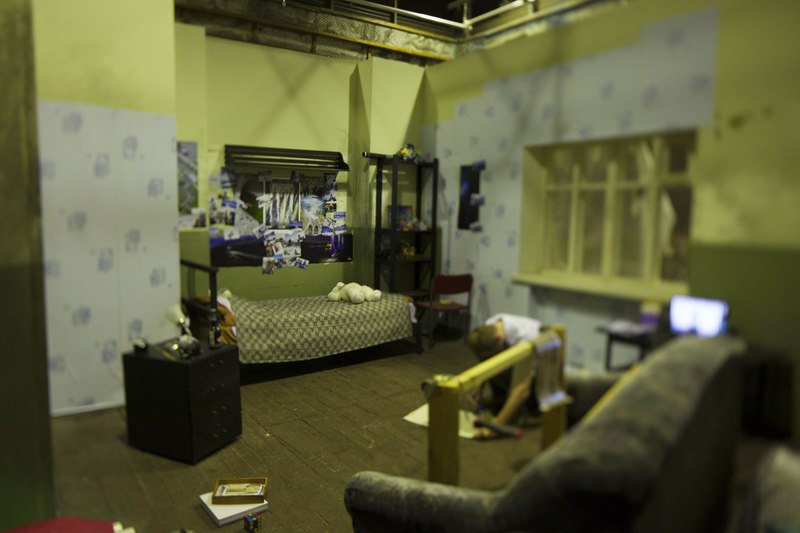

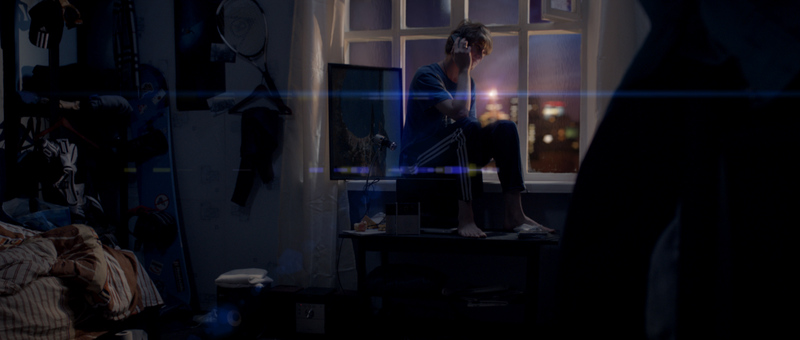
The moments when we see the hero from the street, 50% computer graphics: the window frame, glare (Knoll Light plugin) and reflections on the glass are added to After Effects. At the time when the camera “seeps” through the glass and enters the room, the operator drove away on rails from the chromakey past a window devoid of glass. Subsequently, the glass was finished in After Effects (glass texture + translucent gradient + glare), the distortion from the lens passing through the glass was added with a simple animation of the Turbulent Distortion EZ effect. But the camera’s passage through the wall is real - the camera simply passes from one room of the pavilion to another. The time shown by the clock is also drawn in the afterter; reason: "Well, figs with him!".
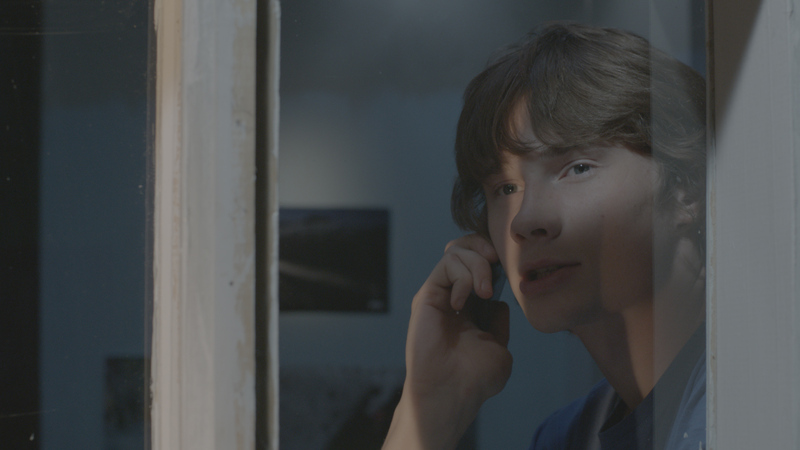
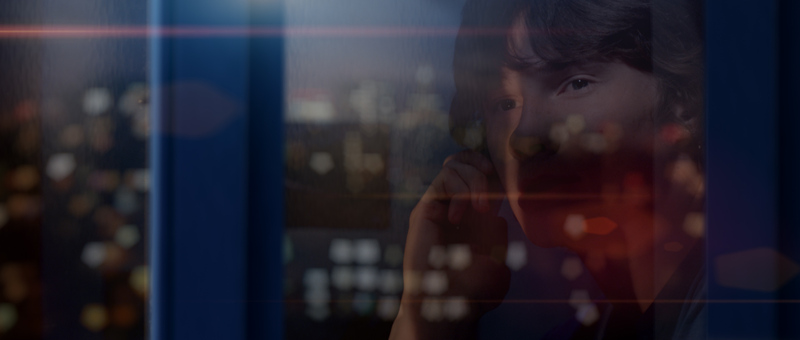
But there were more episodes with chromakey than planned. As soon as the time came to shoot jumping from the roof, the leading actor safely hid in the hospital. The general and long-range plans were ultimately executed by the understudy, and close-ups, after removing the actor from the hospital, were taken to the chromakey in the pavilion. But then we made a number of mistakes. Firstly, on shootings, we ended the paid number of shifts for Arri Alexa and we had to shoot on the Canon Mark II, and competently keit the material shot on the mark, in contrast to the frames shot on alex, is much more difficult. Secondly, we put the actors too close to the green screen, they "fonil". Thirdly, we performed studio color grading before keying ... The result was shocking: the actors in the field glowed with a green halo like Chernobyl mutants. The key actors in After Effects had to be chunks, like Frankenstein’s monsters, applying special keying settings to each of the mask layers. The intermediate material, at times, looked funny.
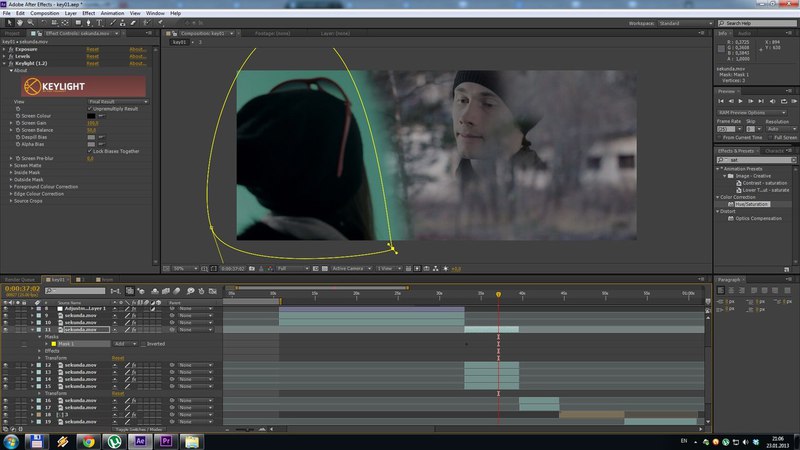
In general, the work took about a year - this is from the moment of writing the script to the final render. Filming took about two months (15 shifts without taking into account the development of locations), post-production took about three months (despite the fact that the New Year's party continued for two weeks!). I foresee a question about the budget: 300,000 rubles. Everything went to the equipment and services of the studio (true, true!).
In conclusion, I want to say that the magic: "Well, figs with him!", Still magical. If we were not familiar with this spell, the charm of working at post-production would not be so charming. However, if you consider ...
Ah, figs with him!


Before filming, I did not plan to use digital processing at all (with the exception of color grading), wanting to achieve the most realistic image. Well, well! .. The magic "figs with him" has incredible power, all sorcerers know this!

I'll start by filming in the forest. If everything is simple and clear with daytime shots, I had to spend on night shots. A van with a generator, a bunch of lighting fixtures illuminating the radiance of camera work night, then color correction in the hope of achieving the desired shade ... Everything went almost according to plan. At least postproduction didn't have to be postponed. Almost ... In the clutter of filming, picking up details of the night without actors, however, was not fate. And the details are needed. But the daily parts of the forest - at least sell at the Air Force! The solution turned out to be logical: we take daytime shots and ... we make night shots from them. Brilliant, isn't it? The main thing is aggressive color correction. And the more aggressive the better!

But in the episode with the rain, the fun itself began. In the story, the actors get wet in the rain and ... um, kiss. The initial shooting plan was as follows: to sit near the river, throw the end of the hose with the pump into the water, and hand the other end to the assistant director, and exclaim: “Oh, God of Rain, give us moisture!”, Enjoy the view of the weeping actors, while hiding himself under the umbrella. But if everything was so, this article would not have appeared, do you understand? .. The Rain God in the person of a younger person, of course, gave us moisture and the actors - as they should be - got wet. Only the God of Rain - just the God of Rain, and not the God of Gravity - and the droplets flew somehow crookedly, then fell on the actors, then flew the devil knows where. And we, having conferred, decided: "Ah, figs with him, at the post-sales we draw!"

As you can see, the settings are animated - this allowed us to change the direction of the wind, the strength and depth of the rain inside each frame, which adds realism.


But according to the plan, we still had to shoot rapid shots. Quote from the director's script: "Rain drops slowly flowing down Katya’s face." I wrote, it seems, not bad, but how to implement the composition of an inflamed brain - you will break your head ... The shooting was conducted on Arri Alexa, the maximum frequency of which is 60 fps. We did not have enough money on Red Epic, and 60 fps is not able to give a proper deceleration. Well hello Twixtor! The film has a lot of slow motion - and all of them were presented to us by our favorite Twixtor plugin. There is a special operation with the twixstor, the quality of the slowdown strongly depends on the quality of the footage: clarity is important, the absence of blurry “intermediate” phases of movement, the absence of camera jerks, the monotony of the background, the maximum contrast of the background and the slowed-down object — what am I crucified if you know the word tweakstore, all this is already known!

The “double” rope is clearly visible in the freeze frame.
But back to the forest rain. The God of Rain on our site, of course, was cool, but not so cool as to conjure falling drops meeeeeally. He is only the God of Rain, and not the God of Gravity. I had to draw in after. This is the standard CC Mr. effect. Mercury, which gives a sensation of moisture adhering to the lens (and if you add a burgundy shade, it also drains blood on the screen), but when you dig deeper into the settings no worse than your nose, you get the illusion of slowly falling drops outside the lens border.

On each frame with drops, three to five layers are created with this effect. The Radius and Producer settings on each layer are different - this allows you to create the illusion of the depth of the frame without working in 3D space.


Having shot the general plans with the rain and having driven the operator to the dolly, it is time for large and medium plans. Suddenly, the battery was near the camera. The God of Electricity would have saved us here, but, alas, he wasn’t on the site - a mechanic with a spare battery was stuck in an “unforeseen” Moscow traffic jam at that time. The film crew eventually waited for him, but the sun did not wait for him. They decided to finish the rain later. When this “later” came, the temperature on the street dropped to zero degrees and I, when I thought about the movie rain,


Now we will pass to the most juicy. “Free Fall Seconds” is a picture of the roopjumpers. And what's the point of watching a movie about extremals if the shooting was not extreme? No, the truth is like silicone boobs! There are many ways to raise a camera into the air without using computer graphics: a crane, ropes, quadrocopter, helicopter, etc. - but at least an orbiting satellite or kamikaze with a lens on its forehead! Each of these methods has its own nuances, image subtleties, geo-referencing, dependence on wind speed and direction, presence / absence of precipitation, there are specifics of camera movement such as smoothness, speed, elevation, etc.
During the pre-production, the idea was to pull the ropes tens of meters and send the operator to hang out at a height of 10-12 floors. But only one operator was available, which caused some complications ... A version of a camera rushing on cables was thought out, flying out over the edge of the crane roof and, as an option, an unnecessary crew member falling from thirty meters. But, thanks to the efforts of the executive producer, an optimal option was found that meets almost all requests for the necessary picture and fits into the budget without human casualties (which is probably important). Radio-controlled helicopter.


Let the word “radio-controlled” not bother you - this toy requires no less care than a transformer. It is controlled by two people: a pilot with a remote control and a cameraman with virtual glasses. The signal from virtual glasses is also duplicated on the director’s monitor. What is missing is perhaps the AI controlling this action from some Deus Ex. However, who knows .......... The duration of the flight in our case is 15 minutes, after which the helicopter must be put on a “refueling”. The load capacity is small, Arri Alexa will not be able to hang, so aerial photography was carried out on Sony FS. Cons of this technical unit: a huge dependence on weather conditions. One of the filming shifts was frustrated due to the sudden onset of rain (there wasn’t any Rain God with us that day, and the weather forecast in the fall for every day is typical and very promising: variable cloud cover), why a tenth of the budget of the film safely disappeared into a puddle. Due to air turbulence, our blade robot was not able to vertically climb 30 meters or more along the building, because there was a danger of collapse, but away from the building or diagonally towards the walls of the building - please. Need in five seconds? - easy! Neither the crane, nor (as far as I know) the quadrocopter is capable of this. A panoramic span of fifty or more meters - in general, beauty! But here the second significant minus immediately makes itself felt. Stabilization. There is always a small proportion of shaking in such shootings (didn’t forget about the “fig with him” spell?), But this is easily stabilized by tracking. Personally, I used the plug-in for After Effects - the easiest to learn Mercalli. Even home cockroaches are able to use it. Due to air turbulence, our blade robot was not able to vertically climb 30 meters or more along the building, because there was a danger of collapse, but away from the building or diagonally towards the walls of the building - please. Need in five seconds? - easy! Neither the crane, nor (as far as I know) the quadrocopter is capable of this. A panoramic span of fifty or more meters - in general, beauty! But here the second significant minus immediately makes itself felt. Stabilization. There is always a small proportion of shaking in such shootings (didn’t forget about the “fig with him” spell?), But this is easily stabilized by tracking. Personally, I used the plug-in for After Effects - the easiest to learn Mercalli. Even home cockroaches are able to use it. Due to air turbulence, our blade robot was not able to vertically climb 30 meters or more along the building, because there was a danger of collapse, but away from the building or diagonally towards the walls of the building - please. Need in five seconds? - easy! Neither the crane, nor (as far as I know) the quadrocopter is capable of this. A panoramic span of fifty or more meters - in general, beauty! But here the second significant minus immediately makes itself felt. Stabilization. There is always a small proportion of shaking in such shootings (didn’t forget about the “fig with him” spell?), But this is easily stabilized by tracking. Personally, I used the plug-in for After Effects - the easiest to learn Mercalli. Even home cockroaches are able to use it. for there was a danger of collapse, but at a distance from the building or diagonally towards the walls of the building - please. Need in five seconds? - easy! Neither the crane, nor (as far as I know) the quadrocopter is capable of this. A panoramic span of fifty or more meters - in general, beauty! But here the second significant minus immediately makes itself felt. Stabilization. There is always a small proportion of shaking in such shootings (didn’t forget about the “fig with him” spell?), But this is easily stabilized by tracking. Personally, I used the plug-in for After Effects - the easiest to learn Mercalli. Even home cockroaches are able to use it. for there was a danger of collapse, but at a distance from the building or diagonally towards the walls of the building - please. Need in five seconds? - easy! Neither the crane, nor (as far as I know) the quadrocopter is capable of this. A panoramic span of fifty or more meters - in general, beauty! But here the second significant minus immediately makes itself felt. Stabilization. There is always a small proportion of shaking in such shootings (didn’t forget about the “fig with him” spell?), But this is easily stabilized by tracking. Personally, I used the plug-in for After Effects - the easiest to learn Mercalli. Even home cockroaches are able to use it. A panoramic span of fifty or more meters - in general, beauty! But here the second significant minus immediately makes itself felt. Stabilization. There is always a small proportion of shaking in such shootings (didn’t forget about the “fig with him” spell?), But this is easily stabilized by tracking. Personally, I used the plug-in for After Effects - the easiest to learn Mercalli. Even home cockroaches are able to use it. A panoramic span of fifty or more meters - in general, beauty! But here the second significant minus immediately makes itself felt. Stabilization. There is always a small proportion of shaking in such shootings (didn’t forget about the “fig with him” spell?), But this is easily stabilized by tracking. Personally, I used the plug-in for After Effects - the easiest to learn Mercalli. Even home cockroaches are able to use it.

After tracking, a second difficulty arises. If you leave helicopter frames at real playback speed, then everything is OK: after digital stabilization, no one will notice the shaking that was once present. But I accelerated many frames ten times that way ... As a result, after tracking there were artifacts that I couldn’t get rid of - a promising distortion. I will explain briefly for those who are in the tank, and not in the helicopter: due to gusts of wind, the radio-controlled bird tilts in one direction or the other. If the playback speed is the same as during the shooting, then after tracking no one will pay attention to it. But it’s worth accelerating the reproduction, as the eye begins to notice that the camera is “swaying”. Just like at the exit of the bar. And the higher the playback speed, the more noticeable "staggering." Tracking stabilizes shaking
In the episode where the hero climbs over the railing and jumps from the railway bridge, the viewer might think that the actor really jumps from the 25 meter bridge. In general, I insisted on this, but for some reason the actor wanted to live. Therefore, I had to take up a simple cinematic technique. As is known to all owners of the brain, the railing at the bridges does not begin at the maximum height. So in our case - from the actor jumping from the bridge to the ground there were no more than two meters, and the angle was chosen so that the viewer did not see the ground. It remains only to put on the montage next to the frame with the feet of the hero on the edge of the abyss - and the illusion of height is provided.

All interior shooting (not including a climbing wall) is a pavilion. They even rented a tent in the pavilion. When we see a city outside the window, in fact we see a green screen (I’m talking about a movie, not about your window). Of course, I was not averse to putting a hologram, but someone whispered in my ear that this was a little expensive. Frames with a night view were shot separately on a time-lapse recorder with a shooting frequency of one frame in five seconds. That is why in the film the lights outside the window blink pleasantly.



The moments when we see the hero from the street, 50% computer graphics: the window frame, glare (Knoll Light plugin) and reflections on the glass are added to After Effects. At the time when the camera “seeps” through the glass and enters the room, the operator drove away on rails from the chromakey past a window devoid of glass. Subsequently, the glass was finished in After Effects (glass texture + translucent gradient + glare), the distortion from the lens passing through the glass was added with a simple animation of the Turbulent Distortion EZ effect. But the camera’s passage through the wall is real - the camera simply passes from one room of the pavilion to another. The time shown by the clock is also drawn in the afterter; reason: "Well, figs with him!".


But there were more episodes with chromakey than planned. As soon as the time came to shoot jumping from the roof, the leading actor safely hid in the hospital. The general and long-range plans were ultimately executed by the understudy, and close-ups, after removing the actor from the hospital, were taken to the chromakey in the pavilion. But then we made a number of mistakes. Firstly, on shootings, we ended the paid number of shifts for Arri Alexa and we had to shoot on the Canon Mark II, and competently keit the material shot on the mark, in contrast to the frames shot on alex, is much more difficult. Secondly, we put the actors too close to the green screen, they "fonil". Thirdly, we performed studio color grading before keying ... The result was shocking: the actors in the field glowed with a green halo like Chernobyl mutants. The key actors in After Effects had to be chunks, like Frankenstein’s monsters, applying special keying settings to each of the mask layers. The intermediate material, at times, looked funny.

In general, the work took about a year - this is from the moment of writing the script to the final render. Filming took about two months (15 shifts without taking into account the development of locations), post-production took about three months (despite the fact that the New Year's party continued for two weeks!). I foresee a question about the budget: 300,000 rubles. Everything went to the equipment and services of the studio (true, true!).
In conclusion, I want to say that the magic: "Well, figs with him!", Still magical. If we were not familiar with this spell, the charm of working at post-production would not be so charming. However, if you consider ...
Ah, figs with him!
